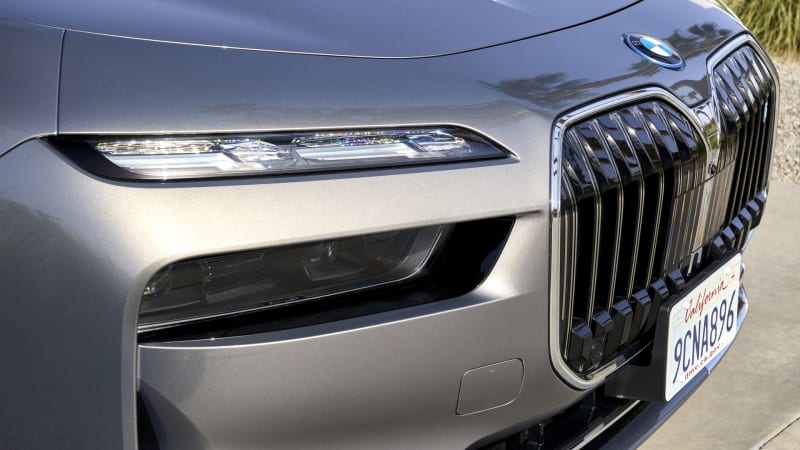It’s been seven years since the BMW 7 Series was last redesigned, and for 2023, we have an all-new seventh generation on the way. If you believe in lucky numbers, this bodes well for BMW’s flagship luxury sedan, but there’s even bigger news. Along with the all-new 7 Series, we’re also getting an all-electric i7 variant.
The 2023 BMW i7 goes on sale at the end of 2022, with a starting price of $120,295 (including $995 destination). On a single charge, the EPA estimates it can travel between 296 and 318 miles depending on wheel choice (bigger equals less), but we wouldn’t be surprised if it exceeds its official figures in real-world driving. A lithium-ion battery pack in the floor with a usable capacity of 101.7-kWh powers the motors on the front and rear axles for all-wheel drive. Combined, they produce 536 horsepower and 549 pound-feet of torque. As much as 605 lb-ft of torque can be momentarily summoned in boost mode by tapping the paddle on the left of the steering wheel.
The i7 is DC fast-charge capable up to a 195-kilowatt rate, which BMW estimates will replenish the battery from 10% to 80% in 34 minutes. As an added incentive, owners can enjoy three years of unlimited free charging on the Electrify America network. On more typical 22-kW level 2 chargers, a full charge from empty should take 5.5 hours. By comparison, the Mercedes-Benz EQS has an EPA-estimated range of either 340 or 350 miles depending on model and should charge from 10-80% in 31 minutes.
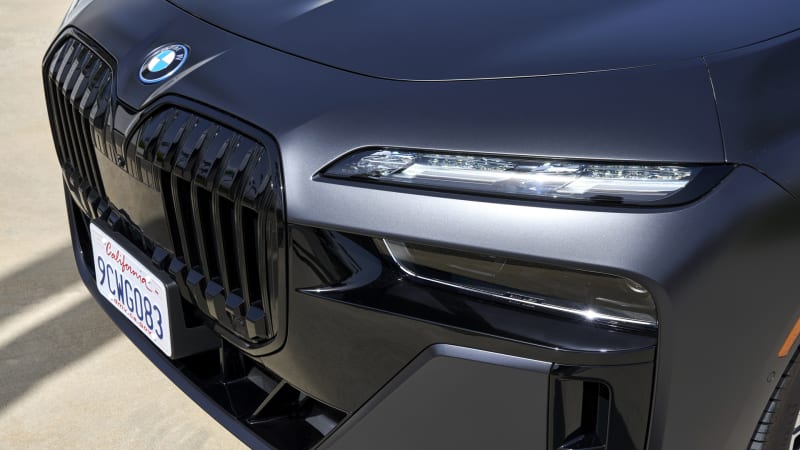
From the outside, there’s little to distinguish the electric i7 from its gasoline-powered 7 Series sibling. That can be good or bad, depending on your tastes and what angle you’re looking from. Up front is a massive version of BMW’s signature kidney grille. It’s flanked by narrow LED accent lights where you’d expect the headlights to be. Those are instead inset and tucked underneath, and join with a vertical air inlet in the corners that channel air around the front wheels.
Shoppers can choose between two aesthetic themes. The Luxury choice (above left) features a grille with chrome accents and a body-colored front fascia while the M Sport (above right) goes with a blacked-out look for the grille and surrounding bodywork. We’re still struggling with the looks of the front end but after a few days of getting familiar with the i7, it’s not quite as jarring as it was initially. For an additional $12,000, you can opt for Maybach-like, two-tone red-and-black or silver-and-gray paint schemes.
The i7’s profile is far less polarizing and retains all of the 7 Series’ personality with a long hood and comparable short rear deck. The recessed black plastic door handles seem out of place, though – why are they not body-colored? The rear end is executed with more grace than the front, with more conventional styling and distinctive horizontal taillights.
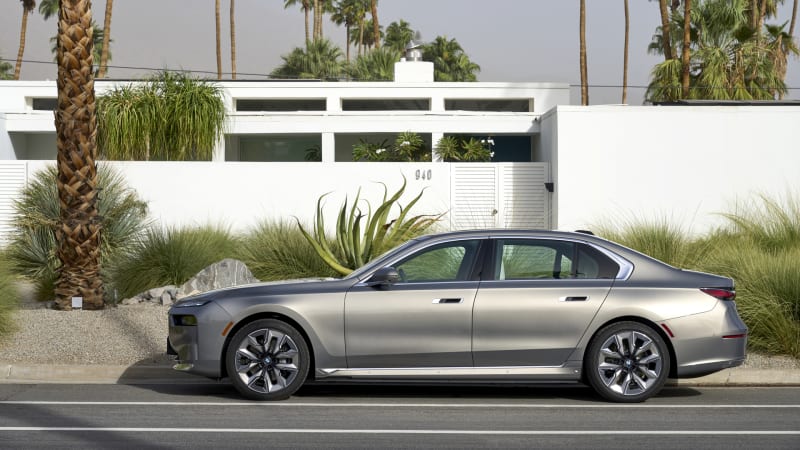
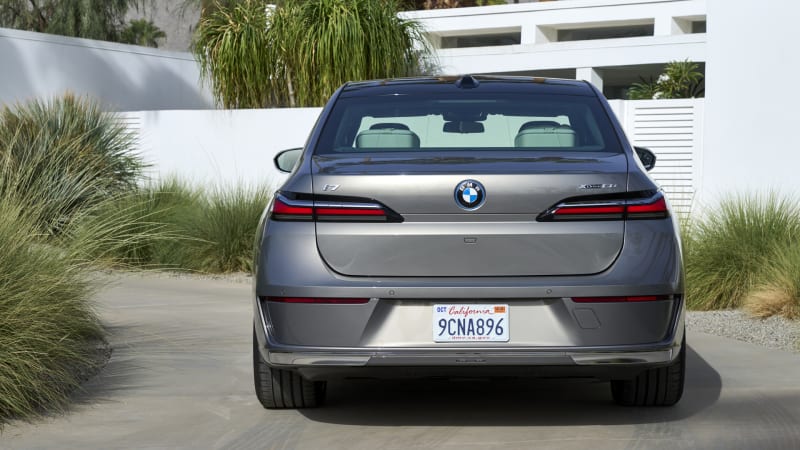
The i7 and 7 Series are only sold as long-wheelbase sedans and have a definite presence on the road. For those wincing at the front-end styling, we suggest spending some time experimenting with BMW’s online configurator to see if there’s a combination of themes and colors that might win them over. Besides styling and aesthetics, the i7 presents a mixed bag of praiseworthy and head-scratching results.
The i7 offers power-operating doors that should open with a simple touch of a button, but the numerous sensors won’t allow for that unless you’re deliberately to the rear of the door. If you’re too close, it will only pop partly ajar until you step to the rear. More often than not, the typical position at the door results in frustration and resorting to pulling the resistant door open. A small button on the edge of the dashboard closes the door with no such issues, but we suggest skipping this option. Like gesture controls, it seems like a feature to impress friends when one first gets the car, but will ultimately rarely use.
Once inside, front passengers are treated to a stylish and modern interior. The dashboard is minimal in design with a long, curved glass sheet enclosing the digital instrument panel and central infotainment touchscreen. A crystal-like trim element hides the air vents and illuminates with the cabin’s mood lighting. Small rubberized dials underneath control the vent direction and air distribution is pleasingly even and effective.
You may want to avoid the gloss carbon fiber (below right) or Mirror Oak dash trim as they tend to reflect annoying sun glare. There’s also glare off the piano black center console and crystal infotainment dial but sadly, there’s no alternate material offered. The leather upholstery is as comfortable as it is attractive, but we’re drawn to the available light gray cashmere wool blend fabric option (below left) for certain color combinations.
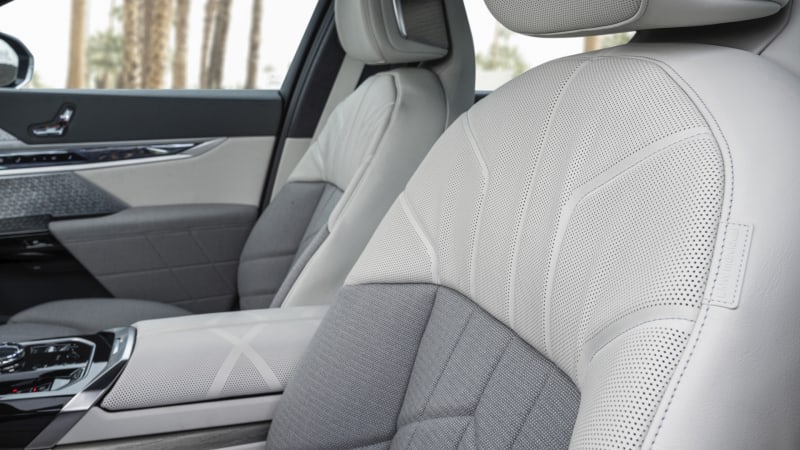
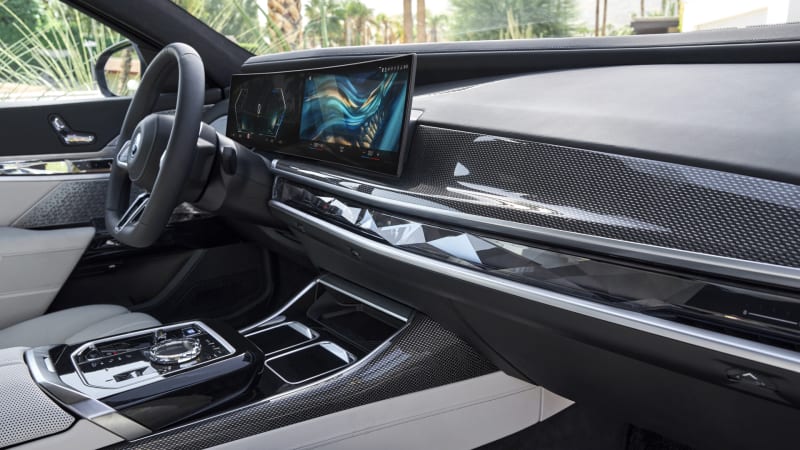
With a tap of the start/stop button, the big luxury sedan springs to life and a tug of the gear selector toggle gets you underway. A single pull puts you in the regular drive mode, while a double pull selects the “B” mode that allows for one-pedal EV driving. Otherwise, the i7 freewheels with little deceleration in the normal drive setting.
Acceleration is instant and with authority. BMW says it will reach 60 mph in 4.5 seconds on its way to a 149-mph top speed. As is the case with most EVs, the i7 gathers speed with eerie silence but if you select Sport mode, a futuristic hum is piped in through the speakers. The sounds are engineered by Academy Award-winning composer Hans Zimmer and add a likable amount of theater to the driving experience.
The “B” driving mode slows the i7 to a graceful stop and is easy to smoothly modulate under all conditions. On a winding road, the suspension ably slices through curves with only moderate body roll. It corners with more athleticism than you’d expect from a 5,917-pound sedan but doesn’t encourage sporty driving. Sport mode firms up the adaptive air suspension for sharper handling and makes the steering noticeably more responsive with increased wheel effort. Rear-wheel steering also makes the i7 more maneuverable than its size suggests and makes lane changes more graceful.
On the whole, it’s pleasing that the i7 delivers the kind of driving experience expected from a BMW 7 Series. Drivers with experience with EVs or past 7 Series should find its driving dynamics appropriate and enjoyable. Sadly, there are some puzzling and annoying technology aspects that spoil the experience.
As we’ve written before, BMW’s latest version of iDrive leaves much to be desired. On a very basic level, it is adequately easy to use. The home screen is configurable and features shortcuts for apps, music, and navigation. There are also temperature controls and a climate control shortcut at the bottom of the display. Things get complicated going forward, though.
There seems to be an endless array of settings deep in the menus that can be distracting and difficult to navigate. For something as simple as adjusting the following distance for the adaptive cruise control, you’ll need to hunt through layers of menus. Voice controls are much improved but that method takes longer to affect a change and also interrupts whatever you’re listening to. We realize that many owners will only need to adjust some settings once in the beginning, but we see the overcomplicated system layout as a step backward for the previously praiseworthy iDrive system.
We’re also not fans of the secondary controls on the center console. The capacitive touch buttons require a deliberate press, which prevents accidental activation, but the buttons are small and the tactile bumps don’t really help enough to allow for no-look operation. In most cases, you’ll need to take your eyes off the road to use them until you’re intimately familiar with the layout.
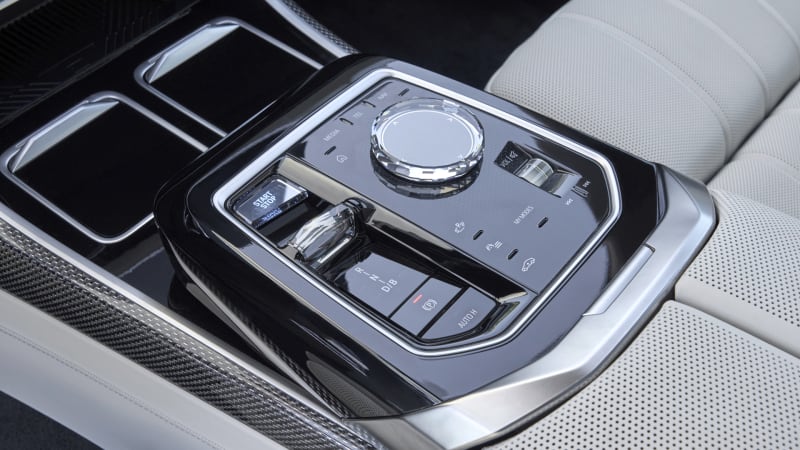
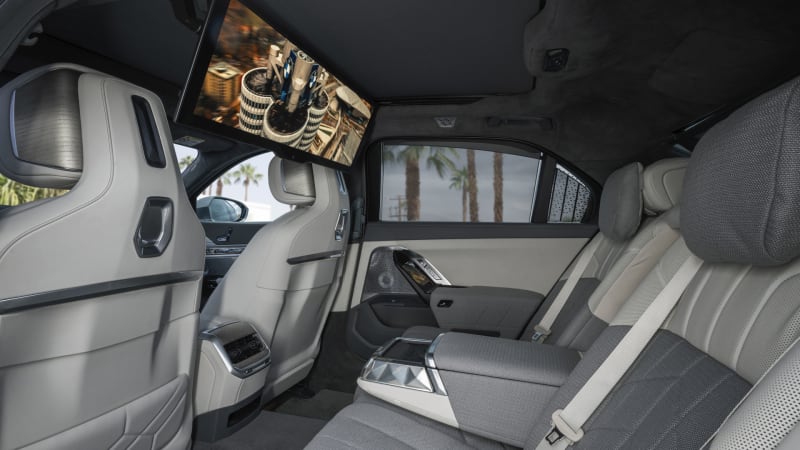
As a long-wheelbase premium luxury sedan, the i7’s rear passenger space offers an abundance of luxury and technology upgrades with their own set of advantages and drawbacks. The available Rear Executive Lounge Seating package adds a reclining passenger-side seat for a business-class experience. Seat ventilation and massage functions actually make it better than business class but it takes quite a while for that seat to adjust and move the front seat out of the way.
A small touchscreen in the rear doors controls everything from music, interior ambiance modes, seat functions, climate, and sunshades. Curiously, there aren’t any navigation controls, which seems like a misstep if you want to select a destination for the driver. The massive new 31.3-inch Theater Screen is visually stunning and selecting Theater mode automatically closes the sunroof and window shades, and pivots the large screen from the roof.
The display has touch functions, but not consistently between apps. For example, when viewing YouTube you can’t simply tap on a title card to start playing. Instead, you need to use a control overlay that mimics the directional and select buttons from the handheld remote. The screen’s central placement also means you’ll need to crane your head slightly to watch and after a short time, that can cause an uncomfortable neck strain. As novel and impactful as the big display is, traditional separate screens are preferable. Thankfully, there are mounting points for individual tablets with convenient power ports on the seat backs.
On top of that, the rear window shade is as opaque as a Las Vegas hotel blackout curtain. That’s apparently to keep from distracting fellow motorists on the road, but it also effectively eliminates the driver’s rearward view. That alone raises some safety concerns, especially as a camera-based virtual rearview mirror is bafflingly not offered.
Not all tech features are so polarizing. The i7’s advanced safety features and driver assists are very well executed. The large head-up display delivers distraction-free information to the driver and augmented reality navigation directions in the instrument panel clearly direct you through unfamiliar areas. The highway driving assistant is particularly well done, as it relieves the driver of a majority of responsibilities. It keeps the car centered in its lane and maintains a consistent gap to vehicles in front. You will have to keep your eyes on the road, though.
From a practicality standpoint, the i7’s 11.4 cubic-foot trunk capacity seems small on paper but in person, it’s quite large and accommodating. The Mercedes EQS’ hatchback design can hold almost double that, but you’d be piling luggage to the ceiling. In practice, it’s comparable to the i7. The Lucid Air also has a large trunk and further benefits from a frunk, unlike the BMW and Benz.
When compared to its rivals in general, the BMW i7 comes up short on range to the EQS and Lucid, but still has more than enough for the average driver. You’ll get slightly more rear passenger space, but the EQS and Air are already more than adequate. The EQS and i7 are similar in price and feature content but take radically different approaches to design and styling. Plus, the EQS doesn’t offer the kind of reclining executive rear seat as the BMW or Lucid. Meanwhile, the Lucid Air’s price undercuts both by tens of thousands of dollars, but it’s also from a startup company and could stand some improvements to braking, handling, and fit and finish. And yes, there is the Tesla Model S in this price range, but it’s such a different car that it makes for imperfect comparisons.
Overall, the 2023 BMW i7 delivers an excellent driving experience and very high levels of comfort – especially if you opt for the Executive Lounge Seating – but so many of its technology features are needlessly complicated. That might be particularly problematic considering that BMW otherwise went down a more traditional path with the i7 compared to its more futuristic rivals. If you’re seeking a more traditional luxury sedan experience from an EV, it stands to reason you may also prefer more traditional controls. In any event, each of these excellent luxury EVs has their own idiosyncrasies and drawbacks – a thorough test drive of them all is recommended to figure out which may work best for your particular needs and tastes.
Related video:

